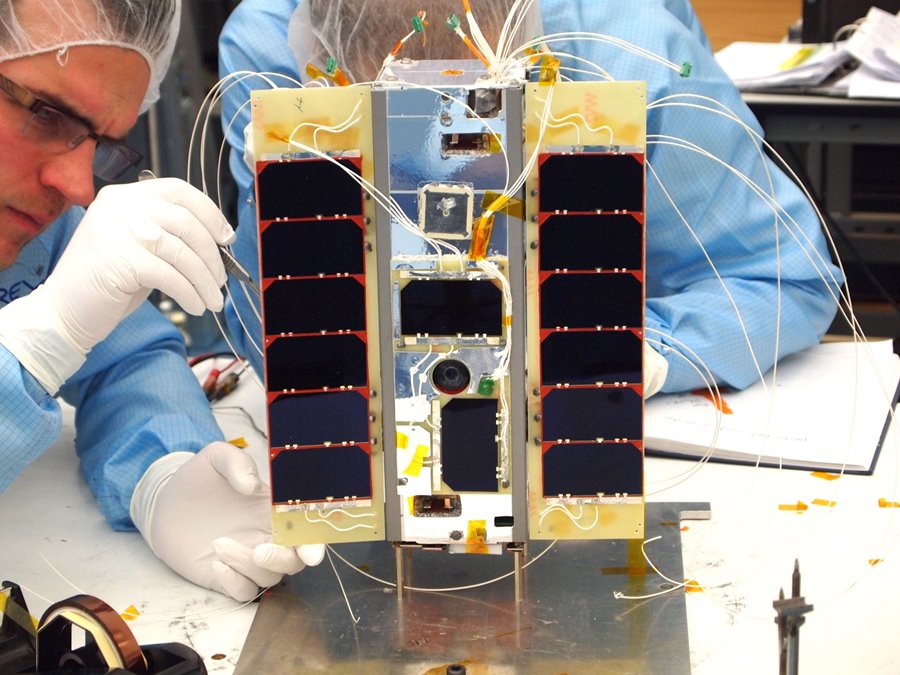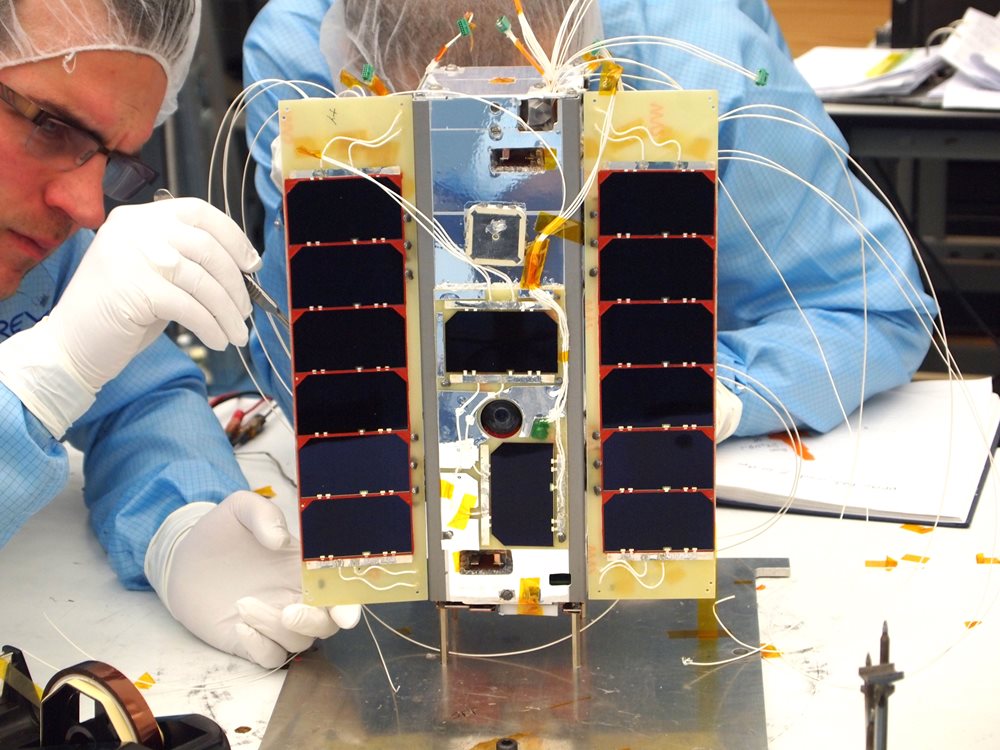
STRaND-1, a nanosatellite carrying a smartphone, has successfully launched into Space from India today.
- STRaND-1 will fly the world's first smartphone in orbit and is the UK’s first CubeSat launched.
- The satellite flies a Google Nexus One smartphone, a new Linux-based high-speed processor and attitude & orbit control system, and two novel propulsion systems (8 pulsed plasma thrusters and a water-alcohol propulsion system).
- STRaND-1 is a training and demonstration mission 3U CubeSat (10cm x 30cm) weighing 4.3 kg, developed by the Surrey Space Centre and Surrey Satellite Technology Ltd.
Launched into a 785km Sun-synchronous orbit on ISRO’s PSLV launcher, the spacecraft is an innovative 3U CubeSat weighing 4.3 kg and is the world’s first “phonesat” to go into orbit, as well as the first UK CubeSat to be launched. Developed by a team from the University of Surrey’s Surrey Space Centre (SSC) and Surrey Satellite Technology Limited (SSTL), STRaND-1 is a training and demonstration mission, designed to test commercial off-the-shelf technologies in space.
Professor Sir Martin Sweeting, SSC Director and also Executive Chairman of SSTL, commented “STRaND-1 from SSC and SSTL is an example of the real synergy of academic research linked to commercial development and exploitation that is the hallmark of Surrey. This mission is a fantastic achievement and a great tribute to the hard work of the engineers involved. The UK’s first nanosatellite SNAP-1, also built by SSC & SSTL and launched in 2000, was the world’s most advanced nanosatellite at the time – STRaND-1 continues that story with the latest technologies available to us in 2013.”
Sir Martin added: “This launch is SSTL’s first with ISRO, and I am looking forward to exploring opportunities for further launches and a wider collaboration on space projects in the future.”
During the first phase of the mission, STRaND-1 will be controlled by the satellite’s attitude control system and a new high-speed linux-based CubeSat computer. During phase two the STRaND-1 team plans to switch many of the satellite’s in-orbit operations to the smartphone, a Google Nexus One which uses the Android operating system, thereby testing the capabilities of many standard smartphone components for a space environment. The smartphone has also been loaded with a number of experimental ‘Apps’, some serious and some just for fun.
STRaND-1 is flying innovative new technologies such as a ‘WARP DRiVE’ (Water Alcohol Resistojet Propulsion Deorbit Re-entry Velocity Experiment) and electric Pulsed Plasma Thrusters (PPTs); both ‘firsts’ to fly on a nanosatellite. The WARP DRiVE propulsion system is designed to deorbit the satellite at the end of its useful lifetime.
STRaND-1 is being commissioned and operated from the Surrey Space Centre’s ground station at the University of Surrey and amateur radio operators can track it from all over the world. Details of the downlink frequency are available at www.amsat-uk.org and we invite radio amateurs world-wide to track STRaND-1. Commissioning is expected to take approximately two weeks, with the switchover to the smartphone and the Apps having to wait until all the other systems onboard the satellite have been fully tested.
The Apps on board STRaND-1 were developed by winners of a Facebook competition held last year:
iTesa will record the magnitude of the magnetic field around the phone during orbit. Used as a precursor to further scientific studies, such as detecting Alfven waves (magnetic oscillations in our upper atmosphere), the iTEsa app could provide proof of principle.
The STRAND Data app will show satellite telemetry on the smartphone's display which can be imaged by an additional camera on-board. This will enable new graphical telemetry to interpret trends.
The 360 app will take images using the smartphone's camera and use the technology onboard the spacecraft to establish STRaND-1's position. The public will be able to request their own unique satellite image of Earth through the website, where images can be seen on a map showing where they have been acquired.
The Scream in Space app was developed by Cambridge University Space Flight and will make full use of the smartphone's speakers. Testing the theory 'in space no-one can hear you scream, made popular in the 1979 film 'Alien', the app will play videos of the best screams while in orbit and screams will be recorded using the smartphone's own microphone.
About Surrey Space Centre, University of Surrey
The Surrey Space Centre (SSC), a Research Centre of the Faculty of Electronics and Physical Sciences (FEPS) at the University of Surrey, is a world leading Centre of Excellence in Space Engineering, whose aim is to underpin the technical development of the space industry through its advanced research programmes.
SSC, comprising over 90 researchers and faculty specialising in small satellite techniques, develops new innovative technologies which are exploited by the space industry. It provides well-focused space engineering education, postgraduate and industrial short courses, training the next generation space scientists, engineers, entrepreneurs and business leaders
www.surrey.ac.uk/SSC
Twitter: @SpaceAtSurrey
About SSTL
Surrey Satellite Technology Limited (SSTL) is the world's leading small satellite company, delivering operational space missions for a range of applications including Earth observation, science and communications. The Company designs, manufactures and operates high performance satellites and ground systems for a fraction of the price normally associated with space missions, with over 500 staff working on turnkey satellite platforms, space-proven satellite subsystems and optical instruments.
Since 1981 SSTL has built and launched 40 satellites – as well as providing training and development programmes, consultancy services, and mission studies for ESA, NASA , international governments and commercial customers, with its innovative approach that is changing the economics of space.
Headquartered in Guildford, UK, SSTL is owned by Astrium BV.
www.sstl.co.uk
